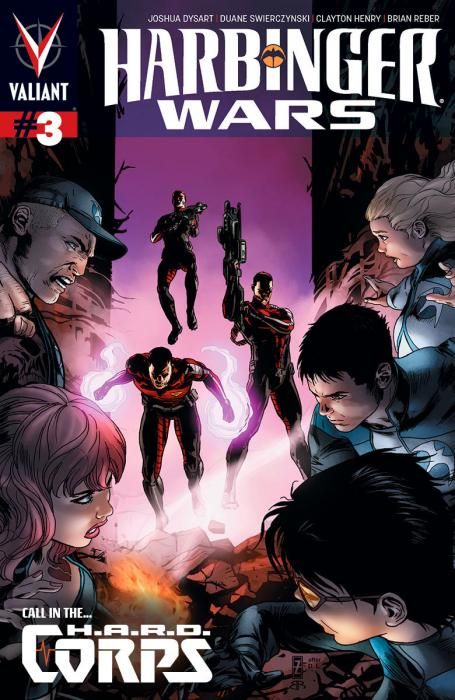In "Harbinger Wars" #3 by Joshua Dysart, Duane Swierczynski, Clayton Henry and Pere Perez, the H.A.R.D. Corps is reactivated and the rival forces of Bloodshot and Harada's Eggbreakers converge in Vegas with the combined forces of The Renegades and Generation Zero.
Individual reactions to "Harbinger Wars" #3 will depend greatly on whether the reader enjoys crossovers in general as a category of comics. The plot is true to type, with a mostly linear timeline and a cast so large that drawing a wall diagram wouldn't be a bad idea. Like most crossover issues, "Harbinger Wars" #3 is heavy on dialogue and direct conflict but short on thematic complexity.
The scale of crossovers results in their greatest strengths and weaknesses as stories. Crossovers are, on one hand, absurdly complicated in how many moving pieces there are, and on the other hand, they are ridiculously simple in the mechanics of conflict and suspense. Usually, the writers throw a bunch of teams with conflicting agendas at each other, the artists sweat about how to fit all the characters into page-gobbling crowded battle scenes and the audience eats popcorn as different gladiator-style match-ups "naturally" occur.
Dysart, Swierczynski, Henry and Perez color within these lines, but to their credit, they do a good job. The recap page is valuable, but by itself, it wouldn't be enough to orient the reader about all the different groups and their agendas, much less the individual characters.
Throughout, the dialogue is distinctive enough that individual personalities come through. The overall mood is one of suspense driven by waiting for the first shot, but Dysart and Swierczynski manage to work in some fleeting but valuable comic moments. Bloodshot gets the best line, with "Kiiddd, youuur mah leathst phavorit," but Faith Hebert, a.k.a Zephyr, also lightens things up with her typically cheery and geeky personality. Fans of the "Harbinger" monthly title will be pleased that The Renegades get a lot of panel space in "Harbinger Wars" #3.
The re-introduction of H.A.R.D. Corps also grabs enough panel space for some well-drawn character introductions. Like the Renegades, the team members of H.A.R.D. Corps are morally flawed characters. Their physical appearances seem to reflect this, and there is also the difference in age from the teenage Renegades. They are hardened in their ways. Heroism seems unlikely in this group of veterans, and the first fatality of battle seems to deliberately underscore their willingness to kill. It's isn't a gory scene, the art team frames the shot to be maximally shocking.
Henry and Perez's artwork is more functional than beautiful, but with this many characters, it's a significant achievement by itself to keep characters distinct and recognizable, all with age-appropriate bodies and faces. If the artwork was any less clear, "Harbinger Wars" #3 would be far more confusing.
However, despite these strengths, the takeaway from "Harbinger Wars" #3 is an overall impression of a lot of chess pieces being moved onto the big board of Vegas. Despite the skill of the creative team, it still feels messy and more cluttered than epic. The cast fights for air because there are too many major players. On the final page, the cliffhanger shows one last powerhouse character on the cusp of being removed from the bench. Until he is in play, total convergence has not occurred. The remaining suspense of "Harbinger Wars" hinges on this final convergence, and on who will survive. So far, "Harbinger Wars" has been a solid crossover, but it isn't ground-breaking.

